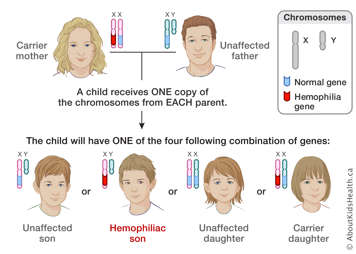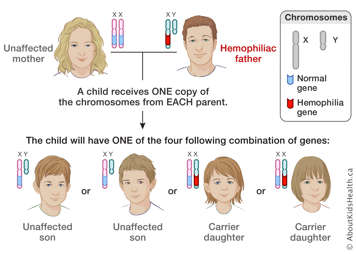What is hemophilia?
Hemophilia is a rare inherited condition that affects the blood's ability to clot effectively. The process of blood clotting helps the body with wound healing and repair. When a healthy person gets a cut, a type of cell in the blood called platelets stick to the wound to try to plug the cut. The platelets release chemical signals calling for help from other platelets and special proteins in the blood called clotting factors. These clotting factors bind together to form chains, called "fibrin". The fibrin forms a net around the platelets preventing them from going back into the bloodstream and holds the clot together to help seal the wound.
There are many different clotting factors, and each one is needed for the fibrin net to form properly. They work together. In most people with hemophilia, levels of either clotting factor VIII (8) or IX (9) are too low so the clotting process slows.
This does not mean that when injured a person with hemophilia will bleed more quickly than a person without hemophilia; they will, however, bleed for a longer period of time.
Different types of hemophilia
Hemophilia A — There is a low level or absent level of clotting factor VIII. This is the most common type of hemophilia, affecting about 80% of people with hemophilia.
Hemophilia B — There is a low level or absent level of clotting factor IX. Only about 20% of people with hemophilia have this type.
| Severity of hemophilia | Percentage of clotting factor in the blood |
|---|---|
| Mild | Greater than 5% up to 40% |
| Moderate | Between 1% to 5% |
| Severe | Less than 1% |
Symptoms of hemophilia
If your child is experiencing any of the following symptoms, you should talk to your doctor about the possibility that your child might have hemophilia:
- prolonged bleeding after circumcision
- easy bruising
- joint and muscle swelling
- prolonged bleeding after cuts, surgery, bloodwork or dental procedures
- mouth bleeds
Symptoms depend on the severity of hemophilia. The severity of hemophilia depends on the levels of clotting factors in the blood.
For mild hemophilia, children typically do not have symptoms for many years. They may have prolonged bleeding after surgery, trauma or dental procedures, such as pulling a tooth.
For moderate hemophilia, children may bruise easily or may have internal bleeding in their joints especially after a fall/trauma.
For severe hemophilia, the symptoms are similar to children with moderate hemophilia except that bleeding is more frequent and more severe. They may have bleeding for no apparent reason in the joints, muscles or internally. Without treatment, people with severe hemophilia can develop serious internal bleeding and long term joint damage from bleeds.
How is hemophilia inherited?
Most often, hemophilia is an inherited condition. This means that it is passed from parents to their children. Hemophilia is caused when there is a mutation, "a mix-up", in one of the genes on the X chromosome. Females have two X chromosomes, while males have one X chromosome and one Y chromosome. For this reason, males and females are affected differently. If a person has at least one normal gene, they will not have hemophilia.

Mothers with the hemophilia gene can pass it on to either their sons or daughters. Their sons may have hemophilia, and their daughters may be carriers, but their children could also be unaffected. There is 50% chance of having a boy with hemophilia if the mother is a carrier, and 50% chance of having a girl who is a carrier.

Fathers with hemophilia will not have sons with hemophilia. However, their daughters will always be carriers.
How does the hemophilia gene affect males and females differently?
Hemophilia most often affects males; females may be carriers of the condition.
Females
If a female has the hemophilia gene on one of her X chromosomes, she will either not be affected or will experience only very mild bleeding symptoms, such as heavier periods. She would be a "carrier", meaning that while she is not affected, she could pass hemophilia to her son. For a female to have hemophilia, she must receive the hemophilia gene from both parents.
Males
Males have only one X chromosome, and therefore only require one X chromosome with the hemophilia gene to have the condition. Males can only get the X chromosome from their mother. Their father always passes on the Y chromosome.
Diagnosis of hemophilia
Before birth
If you know that hemophilia runs in your family, you might choose to have your baby tested while it is still in the womb (prenatal testing). If prenatal testing is not completed but the woman is carrying a male fetus it is best to assume that the child has hemophilia and to take appropriate steps during the birthing.
After birth
In cases where there is no known family history of hemophilia, it may not be diagnosed until parents begin to notice bleeding symptoms. A blood test can confirm the diagnosis of hemophilia as well as how severe it is and whether it is hemophilia A or B.
Treatment of hemophilia
Hemophilia is a lifelong condition that will require regular care. There are several treatment methods for hemophilia. The method and timing of treatment chosen will depend on the type and severity of your child's hemophilia, and will be discussed with their health care team.
On demand treatment
If your child has mild hemophilia, or bleeds infrequently, their health care team may choose to give them a dose of clotting factor only when an injury occurs.
Prophylaxis (or preventative treatment)
If your child has severe hemophilia, or has severe bleeds often, they may need clotting factor on a regular basis to prevent bleeds from happening. Regularity of dose may be anywhere from once a day to weekly.
Treatments by type
| Type of hemophilia | Treatment options |
|---|---|
| Hemophilia A |
|
| Hemophilia B |
|
Desmopressin (DDAVP)
People with mild or moderate hemophilia A might be treated with a medication called Desmopressin (DDAVP) for mild to moderate bleeds. DDAVP is a chemical that helps to release factor VIII that is already stored in the body. Before using this method, your child's health care team will perform a "DDAVP Challenge". This is a test that will allow them to see if the use of DDAVP releases enough factor VIII in your child's body to prevent and treat bleeds. Treatment of hemophilia with DDAVP is not recommended until your child is at least three years of age.
Hemophilia comprehensive health-care team
There is excellent medical treatment for people with hemophilia. You and your child can look forward to living complete, happy and normal lives with the support of a comprehensive team of health care specialists. This team will include a nurse coordinator, hematologist (blood doctor), physiotherapist, and social worker.
